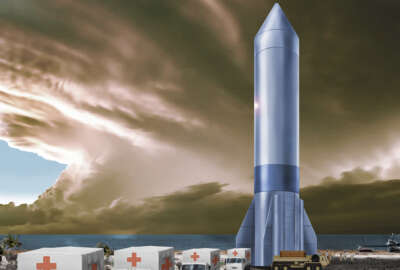The Department of the Air Force thinks its long-term dream of delivering cargo on earth at hyper-fast speeds using rockets shot into space might actually be attainable in the near future.
The service is launching Rocket Cargo as its fourth vanguard program to deliver game changing capabilities to advance service members’ battle advantage.
“Rocket cargo is envisioned as a Defense Department interface with commercial capabilities, where we deliver up to 100 tons of cargo anywhere on the planet on tactical timelines,” Maj. Gen. Heather Pringle, Air Force Research Laboratory commander, told reporters Friday. “This newest vanguard has the support of the entire Department of the Air Force, and if successful, will be partnered with the right team to transition this to warfighters.”
One hundred tons is about the same amount of cargo space as a C-17.
“Rapid logistics underpins our ability to project power,” said Gen. Arnold Bunch, Air Force Materiel Command leader. “That is the fundamental motivation for initiating the Rocket Cargo program. We see its initial applications in swiftly restoring operational capability for forces forward in austere environments, as well as dramatically reducing the time required to deliver crucial humanitarian assistance and disaster relief.”
The program will be heavily reliant on commercial partners, since space companies are already highly interested in reentry rockets. The Air Force plans to work on industry’s timeline, and not drive the program through requirements. Instead, the service will allow the private sector to continue developing the technology and then work in the Space and Missile Center and Air Force Research Laboratory to have military applications ready as soon as the commercial side is ready.
That includes looking at ways to pre-certify cargo and containers to quicken the packing process, finding ways to quicken the logistics of packing and unpacking cargo and even entertaining the possibility of using the rockets to rapidly deploy troops.
The Air Force is working under the assumption that companies will develop landing pads around the world, but the service would also like to look into landing the rockets in austere environments that could deliver capabilities to nearly anywhere on the planet.
Air Force officials said they would like to use multiple vendors for the process, and not just SpaceX, which has conducted successful reentry launches.
The dream of a terrestrial rocket-based cargo delivery system has been around for decades, but the service now thinks that higher capabilities and lower cost points have made it much more feasible.
“People always wonder why are we looking at this idea again. This idea is been around since the dawn of spaceflight, it’s always been an intriguing idea. We look at it about every 10 years and it’s never really made sense in the past,” Greg Spanjers, Rocket Cargo program manager said. “What has changed is a major emergence on the commercial side with much higher capability rockets at a much lower cost point than we’re used to seeing.”
At this point, companies are using their own money for reentry systems and DoD does not have to do the initial investment.
The Air Force also plans on partnering with U.S. Transportation Command, which is looking for terrestrial reentry capabilities. The combatant command is already working with SpaceX on contracting reentry flights.
“Think about moving the equivalent of a C-17 payload anywhere on the globe in less than an hour,” TRANSCOM Commander Gen. Stephen Lyons said last October. “Think about that speed associated with the movement of transportation of cargo and people. There is a lot of potential here and I’m really excited about the team that’s working with SpaceX on an opportunity, even perhaps, as early as 21, to be conducting a proof of principle.”
TRANSCOM is using cooperative research and development agreements to facilitate interagency and commercial work on the project.
Copyright
© 2024 Federal News Network. All rights reserved. This website is not intended for users located within the European Economic Area.

